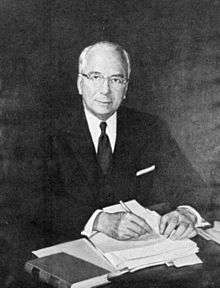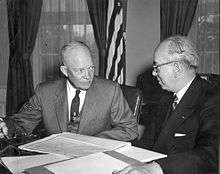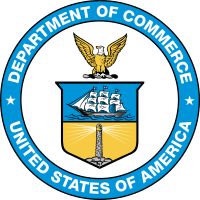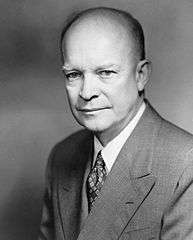Lewis Strauss
| Lewis Strauss | |
|---|---|
 | |
| United States Secretary of Commerce Acting | |
|
In office November 13, 1958 – June 30, 1959 | |
| President | Dwight Eisenhower |
| Preceded by | Sinclair Weeks |
| Succeeded by | Frederick Mueller |
| Personal details | |
| Born |
Lewis Lichtenstein Strauss January 31, 1896 Charleston, West Virginia, U.S. |
| Died |
January 21, 1974 (aged 77) Trenton, New Jersey, U.S. |
| Political party | Republican |
| Alma mater | University of Virginia |

Lewis Lichtenstein Strauss (pronounced straws /ˈstrɔːz/; January 31, 1896 – January 21, 1974) was a Jewish American businessman, philanthropist, public official, and naval officer. He was a major figure in the development of nuclear weapons and nuclear power in the United States.[1]
Strauss was the driving force in the hearings, held in April 1954 before a U.S. Atomic Energy Commission Personnel Security Board, in which J. Robert Oppenheimer's security clearance was revoked. President Eisenhower's nomination of Strauss to become U.S. Secretary of Commerce in 1959 was not confirmed by the Senate.
Early life
Strauss was born in Charleston, West Virginia, the son of Rosa (Lichtenstein) and Lewis Strauss, a successful shoe wholesaler. At the age of 10, he permanently lost the vision in his right eye in a rock fight. This injury later disqualified him from normal military service. His family relocated to Richmond, Virginia. He was valedictorian of his high school class, though due to typhoid fever in his senior year, he was unable to graduate with his class.[2]
Strauss had planned to study physics at the University of Virginia.[3] But when he finally graduated, his family's business had had a downturn, and they could not afford to send him.[4] For the next three years Strauss worked as a traveling shoe salesman for his father's company. He was the company's top salesman, and saved enough money for college tuition.
However, Strauss' mother had also encouraged him to perform some kind of public or humanitarian service. It was 1917. World War I was raging in Europe, and Herbert Hoover was head of the United States Food Administration (USFA). Strauss volunteered to serve without pay as Hoover's assistant.[5] Strauss worked hard and well, and soon was promoted to Hoover's private secretary, a post in which he made powerful contacts that would serve him later on. His service with the USFA lasted until 1919.
Strauss himself became a man of influence: acting on behalf of a representative of Finland, he persuaded Hoover to urge President Woodrow Wilson to recognize Finland's independence from Russia.
Besides the USFA and its successor, the American Relief Administration, Strauss worked with the American Jewish Joint Distribution Committee (JJDC) to relieve the suffering of Jewish refugees, who were often neglected by other bodies. The poor treatment of Polish and Russian Jews that Strauss witnessed instilled in him a powerful anti-Communist sentiment. At the JJDC, Strauss came to the attention of Felix M. Warburg, a partner in the investment bank Kuhn, Loeb & Co. in New York City.
Warburg brought Strauss to Kuhn Loeb, where he became a full partner in 1929 and was active in the firm until 1941. During this period Strauss became wealthy.
Strauss also became a leader in Jewish causes and organizations. For instance, in 1933 he was a member of the Executive Committee of the American Jewish Committee. However, he was not a Zionist and opposed the establishment of a Jewish state in Palestine. He instead supported assimilation of Jews as equal citizens of the nations where they lived. He recognized the brutality of governments like Nazi Germany; in 1938 he joined with Hoover and Bernard Baruch in supporting the establishment of a refugee state in Africa as a safe haven for all persecuted people, not just Jews.
World War II
Despite his disqualification for regular military duty, Strauss applied to join the Navy Reserve in 1925, and received an officer's commission as an intelligence officer. In 1939 and 1940, as World War II began, he volunteered for active duty, and in 1941, he was called up. He was assigned to the Bureau of Ordnance, where he helped organize and manage Navy munitions work.[1] His contributions were recognized by Secretary of the Navy Frank Knox, and he served on the Army-Navy Munitions Board and the Naval Reserve Policy Board.
When James V. Forrestal succeeded Knox in 1944, he employed Strauss as his personal trouble-shooter. In November 1945, after the war, Strauss was promoted to Rear Admiral by President Truman.[6]
Strauss and the atomic bomb
Strauss' mother died of cancer in 1935; his father in 1937. Because of this, and his early interest in physics, Strauss established a fund for physics research that could lead to better radiation treatment for cancer patients. The fund supported Arno Brasch, who was working on producing artificial radioactive material with bursts of X-rays. Brasch's work was based on previous work with Leo Szilard, who saw in this work a possible means to developing an atomic chain reaction. Szilard had already foreseen that this could lead to an atomic bomb. Szilard persuaded Strauss to support him and Brasch in building a "surge generator"; he ultimately provided $20,000.
Through Szilard, Strauss met other nuclear physicists such as Ernest Lawrence. Szilard kept him up to date on developments in the area, such as the discovery of nuclear fission and the use of neutrons. In February 1940 Szilard asked him to fund the acquisition of some radium, but Strauss refused, having already spent a large sum.
Strauss had no further direct involvement with atomic-bomb development during the war. At the end of the war, when the first atomic bombs were ready for use, he advocated dropping one on a symbolic target, such as a cedar forest held in reverence by the Japanese, as a warning shot. He also recommended a test of the atomic bomb against a number of modern warships, which he thought would refute the idea that the atomic bomb made the Navy obsolete. This led to Operation Crossroads, the first atomic bomb test at Bikini Atoll.
The Atomic Energy Commission
In 1947, the U.S. transferred control of atomic research from the Army to civilian authority under the newly created Atomic Energy Commission (AEC). Strauss was appointed by President Truman as one of the first five Commissioners. He served on the AEC until 1950. As a Commissioner, Strauss was very disturbed by the security breaches that were revealed in the postwar years, including the presence of Soviet spies in the Manhattan Project. He supported draconian measures to improve security, including the removal of scientists with "questionable" backgrounds, including many who had played major roles in the wartime research. He opposed the broad cooperation with Britain that had been informally promised by Roosevelt. He was increasingly unhappy in his position, but President Truman asked him to stay on. Strauss also urged that the U.S. move immediately to develop the hydrogen bomb. When Truman signed the directive for hydrogen bomb development in 1950, Strauss, considering that he had accomplished as much as he could, resigned the same day.
Strauss became a financial adviser to the Rockefeller brothers, but continued to take an interest in atomic affairs.
In 1953, President Eisenhower appointed Strauss as chairman of the AEC. Strauss was by this time one of the best known advocates of atomic energy for many purposes. At Eisenhower's request, Strauss had the AEC develop the "Atoms for Peace" program which Eisenhower announced in December 1953.
In 1954, Strauss predicted that atomic power would make electricity "too cheap to meter."[7][8] He was possibly referring to Project Sherwood, a then secret program to develop power from hydrogen fusion, rather than uranium fission reactors as was commonly believed.[9] [10]
Strauss and Oppenheimer
During his term as an AEC commissioner, Strauss became hostile to J. Robert Oppenheimer, the physicist who had been scientific director of the Manhattan Project.
In 1947, Strauss, then a trustee of the Institute for Advanced Study at Princeton, presented Oppenheimer with the Institute's offer to be its director. But Strauss, a conservative Republican, had little in common with Oppenheimer, a liberal who had had Communist associations. Oppenheimer opposed H-bomb research and proposed a national security strategy based on nuclear weapons and continental defense; Strauss favored the development of thermonuclear weapons and a doctrine of deterrence. Oppenheimer favored a policy of "candor" regarding the numbers and capabilities of the atomic weapons in America's arsenal; Strauss believed such unilateral frankness would benefit no one but Soviet military planners.[11]
When Eisenhower offered Strauss the AEC chairmanship, Strauss named one condition: that Oppenheimer would be excluded from all classified atomic work. Oppenheimer then sat on the General Advisory Committee (GAC) of senior atomic scientists which reported to the AEC, and held a Q clearance. He was one of the most respected figures in atomic science, even briefing the President and National Security Council in 1953.
Strauss, however, deeply distrusted Oppenheimer. He had become aware of Oppenheimer's former Communist affiliations (before World War II), and questionable behavior during the war, and began to think that Oppenheimer might even be a Soviet spy. Strauss was also suspicious of Oppenheimer's tendency to downplay Soviet capabilities. In 1953 Oppenheimer stated in the July edition of Foreign Affairs that he believed the Soviets were "about four years behind" in atomic weapons development. The U.S. had exploded the first thermonuclear device the previous year, although it required a two-story building filled with refrigeration equipment to chill the liquid hydrogen. Yet only a month after Oppenheimer made his proclamation, in August 1953, the Soviet Union declared, and U.S. sensors confirmed, that it had tested its own hydrogen bomb. (It was not, however, a staged thermonuclear weapon of the Teller-Ulam design. Scholars have debated for some time whether the Soviet Joe 4 device should be considered a true hydrogen bomb. The first Soviet test of an undisputedly "true" hydrogen bomb was not until 1955.) Moreover, the Soviet device relied on solid lithium-6 deuteride rather than liquid hydrogen to boost the yield, making the Soviet device the first truly deliverable thermonuclear weapon which proved that the United States was the country trailing technologically in nuclear weapon capability.[12]
In September 1953, Strauss, hoping to uncover evidence of Oppenheimer's disloyalty, asked FBI director J. Edgar Hoover to initiate surveillance to track Oppenheimer's movements. Hoover agreed enthusiastically. The tracking uncovered no evidence of disloyalty but did reveal Oppenheimer had lied to Strauss about his reason for taking a trip to Washington (Oppenheimer met a journalist rather than visit the White House as he had told Strauss).[13] Strauss' suspicions increased further with the discovery that Oppenheimer had tried to stop America's long-range detection system in 1948 and 1949, which was the time frame when the Soviet Union exploded its first atomic weapon. In December 1953, the FBI notified Strauss that it would not watch Oppenheimer more closely without a specific request, which Strauss provided. Hoover then ordered full surveillance on Oppenheimer, including illegally tapping his phones.[14]
At first Strauss moved cautiously, even heading off an attack on Oppenheimer by Senator Joseph McCarthy. He had the AEC staff compile a list of charges, and surprised Oppenheimer with them in December 1953.
Strauss is perhaps most remembered as the driving force in the month-long hearings, held in April and May 1954, before an AEC Personnel Security Board that resulted in Oppenheimer's security clearance being revoked. Strauss had access to the FBI's information on Oppenheimer, including his conversations with his lawyers,[15] which was used to prepare counterarguments in advance. In the end, despite the support of numerous leading scientists and other prominent figures, Oppenheimer was stripped of his clearance as Strauss had wanted. Strauss was painted as a witch-hunter, pursuing a vendetta fueled equally by personal dislike and paranoid suspicions.[16] [17] [18]
After the AEC
Strauss' term as AEC chair ended in 1958. Eisenhower wanted to reappoint him, but Strauss feared the Senate would reject him, and would in any case subject him to ferocious questioning. Besides the Oppenheimer affair, he had clashed with Senate Democrats on several major issues (including the Dixon-Yates contract).
Eisenhower offered him the post of White House Chief of Staff, but Strauss did not think it would suit him. Eisenhower also asked if Strauss would consider succeeding John Foster Dulles (who was ill) as Secretary of State, but Strauss did not want to pre-empt Undersecretary Christian Herter, who was a good friend.
Finally Eisenhower proposed that Strauss become Secretary of Commerce, and this Strauss accepted. He took office as an interim appointee in November 1958. However, Senate opposition to this appointment was as strong as to a renewed AEC term. At the time, the 13 previous nominees for this Cabinet position won Senate confirmation in an average of eight days.[19] Because of both personal and professional disagreements, Senator Clinton Presba Anderson took up the cause to make sure that Strauss would not be confirmed by the Senate. Senator Anderson found an ally in Senator Gale W. McGee on the Senate Commerce Committee, which had jurisdiction over Mr. Strauss' confirmation. During and after the Senate hearings, Senator McGee had charged Mr. Strauss with "a brazen attempt to hoodwink" the committee.[19] After 16 days of hearings the Committee recommended Strauss' confirmation to the full Senate by a vote of 9-8. In preparation for the floor debate on the nomination, the Democratic majority's main argument against the nomination was that Strauss' statements before the Committee were "sprinkled with half truths and even lies...and that under rough and hostile questioning, [he] can be evasive and quibblesome."[19] Despite an overwhelming Democratic majority, the 86th United States Congress was not able to accomplish much of their agenda since the President had immense popularity and a veto pen.[19] With the 1960 elections nearing, congressional Democrats sought issues on which they could conspicuously oppose the Republican administration. The Strauss nomination proved tailor made.[20]
On June 19, 1959, just after midnight, the Strauss nomination failed by a vote 46-49. At the time, It marked only the eighth time in U.S. history that a Cabinet appointee had failed to be confirmed.[1] [21] This effectively ended his government career. Reportedly, Strauss never recovered from this.[22]
On July 14, 1958, Strauss was presented with the Presidential Medal of Freedom by President Eisenhower.[23] Strauss died in Brandy Station, Virginia in 1974.
Sources
- The American Presidency Project
- Bird, Kai; Sherwin, Martin J. (2005), American Prometheus. The Triumph and Tragedy of J. Robert Oppenheimer
- Pfau, Richard (1984). No Sacrifice Too Great: The Life of Lewis L. Strauss. Charlottesville, Virginia: University Press of Virginia. ISBN 978-0-8139-1038-3.
- Rhodes, Richard (1995), Dark Sun: The Making of the Hydrogen Bomb, New York: Simon and Schuster, ISBN 0-684-80400-X
- Rhodes, Richard (1986), The Making of the Atomic Bomb, New York: Simon and Schuster, ISBN 0-671-44133-7
References
- 1 2 3 "Archived copy". Archived from the original on 2010-09-07. Retrieved 2009-08-21.
- ↑ Pfau, Richard (1984) No Sacrifice Too Great: The Life of Lewis L. Strauss University Press of Virginia, Charlottesville, Virginia, p. 7, ISBN 978-0-8139-1038-3.
- ↑ Pfau, p. 7
- ↑ Pfau, p. 7-9
- ↑ Pfau, p. 11-12.
- ↑ "Archived copy". Archived from the original on 2010-04-07. Retrieved 2010-01-29.
- ↑ Too Cheap to Meter?
- ↑ Full text of speech
- ↑ Pfau, p. 187
- ↑ David Bodansky. Nuclear Energy: Principles, Practices, and Prospects. p. 32. Retrieved 2008-01-31.
- ↑ Pfau,p. 144
- ↑ Pfau,p. 146
- ↑ Pfau,p. 148
- ↑ Pfau,p. 157
- ↑ Pfau,p. 159-160
- ↑ Rhodes, Richard (1995), Dark Sun: The Making of the Hydrogen Bomb, New York: Simon and Schuster, ISBN 0-684-80400-X
- ↑ Rhodes, Richard (1986), The Making of the Atomic Bomb, New York: Simon and Schuster, ISBN 0-671-44133-7
- ↑ Bird, Kai; Sherwin, Martin J., American Prometheus. The Triumph and Tragedy of J. Robert Oppenheimer
- 1 2 3 4 http://www.time.com/time/magazine/article/0,91771,892639,00.html. Missing or empty
|title=(help) - ↑
- ↑ http://www.time.com/time/magazine/article/0,91771,864640,00.html. Missing or empty
|title=(help) - ↑ Goodchild, P. J. Robert Oppenheimer: Shatterer of Worlds. Fromm International, 1985.
- ↑ Pfau, Richard (1984) No Sacrifice Too Great: The Life of Lewis L. Strauss University Press of Virginia, Charlottesville, Virginia, p. 222 ISBN 978-0-8139-1038-3
External links
- Annotated bibliography for Lewis Strauss from the Alsos Digital Library for Nuclear Issues
- Guide to the Papers of Admiral Lewis Lichtenstein Strauss (1896-1974) at the American Jewish Historical Society, New York.
| Legal offices | ||
|---|---|---|
| Preceded by Sinclair Weeks |
United States Secretary of Commerce Acting 1958–1959 |
Succeeded by Frederick Mueller |

